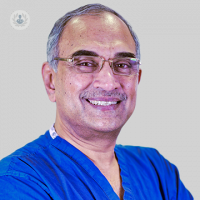FAQs on breast implant complications
Written in association with:Whether you’re getting breast implants for the first time, replacing the ones you have or removing them entirely, you are bound to have some worries. In this article Mr Venkat Ramakrishnan discusses the link between breast cancer and implants and covers some of the most common patient concerns surrounding implant removal, sagging skin, scars and breast implant illness (BII).

Do breast implants cause cancer?
Over the last ten years, many types of breast implants - mainly rough-surfaced implants - have been mistakenly associated with breast cancer. The confusion lies with a rare type of cancer called anaplastic large cell lymphoma (ALCL) which can form around the breast implant. This is not a form of breast cancer, but instead, a rare type of cancer of the immune system supposedly caused by the friction between the implant and the body tissue.
The incidence of ALCL is variable depending on the type of implant used, which might be anywhere between 1:6000 to 1:80000, but is even less if smooth-surfaced implants are used.
How will I know if I have cancer following breast implants?
The usual symptom is sudden swelling of one of the breasts and is caused by built-up fluid accumulating around the implant. If this occurs, you should be checked over by a doctor for any rogue cells. During the check-up, an ultrasound is done to ensure that the implant hasn’t ruptured. The fluid is then extracted from the breast and sent for testing and a subsequent diagnosis can be made. This condition is fairly common in patients but it’s important to note that very few actually have ALCL.
If that’s the case, why can’t you always use smooth implants if there’s less of a chance of ALCL?
It is possible to use smooth-surfaced implants instead of the rough-surfaced type, however, we tend to use the latter to limit encapsulation (where a capsule of natural tissue forms around a breast implant). It is thought that smooth implants have more of a risk of encapsulation, thereby needing to be removed and replaced earlier than a rough surfaced-implant would.
Do breast implants cause breast implant illness (BII)?
There have been numerous discussions about this over the last 30 years. Breast implant illness is a term used by some patients who describe a variety of symptoms including, fatigue, chest pain, headaches, brain fog, sleep disturbance, depression, hormonal issues, etc. after receiving breast implants.
Many professionals have studied this in detail and, at present, there’s been no link proven. However, this isn’t to say that they are not connected. The medical evidence we have simply does not link having silicone in the body directly to the problems that have been attributed. Many of these symptoms do also occur in patients without implants.
Will removing the implants make the symptoms go away?
I have had patients who were convinced that their symptoms of malaise (general feeling of illness) and tiredness went away after removing the implants. I cannot explain this by any scientific means, however, patients have to consider the benefits of removing the implants and therefore, not having any replacement ones.
What happens if implants are removed years later and not replaced?
After a while, the skin stretches to the shape of the new implant. If you were to take the implant out, after having it between 15 – 20 years, the skin wouldn’t shrink back to its original form straight away. The main factor of this is age. As you age, the skin loses its elasticity and breast tissue also loses its overall volume. Taking this into account, the skin likely wouldn’t shrink back and there would be increased droopiness of the breast.
Can you remove the implants and fill the breasts with fat injections?
It is possible to remove the implant in the first instance and then add fat to the breast in stages, but this is not without its problems.
To increase the cup size of the breast, we would need about a 100 to 120ml volume increase. To achieve this, we would need to harvest about 250ml of fat. As this is for both breasts, that would double, so 500ml of fat at each sitting would be required. Generally, we can increase the breast by two or three cups sizes in two to three sittings. It’s important to note that some of the fat we place does get reabsorbed by the body and some of the fat cells die, while others lead to scarring of the breast. The main issue with scarring is that the build-up of calcium can be confused with cancer. Although injecting fat does not cause cancer, it can make it difficult to diagnose problems in the breast due to the calcium being present.
What is “en bloc capsulectomy”?
An en bloc capsulectomy involves removing the implant and scar tissue as a whole. It involves a longer skin incision, longer operation times and a lot of damage to the breast tissue. It is not an operation to be taken lightly and has a limited role in implant removal. In addition, it can cause considerable damage to the breast and rib cage, hence this procedure is not routinely recommended.
If you are experiencing any of the symptoms mentioned in this article and would like to see a specialist, visit Mr Venkat Ramakrishnan‘s profile and make an appointment to see him.


